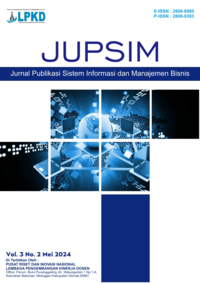Pengaruh Literasi Keuangan dan Kontrol Diri terhadap Pengelolaan Keuangan UMKM
DOI:
https://doi.org/10.55606/jupsim.v4i2.4039Kata Kunci:
Monetary Proficiency, MSME Monetary Administration, Self-ControlAbstrak
This investigate looks at the affect of monetary proficiency and self-control on the money related administration of miniaturized scale, little, and medium ventures (MSMEs). With MSMEs playing a significant part in financial improvement, understanding their budgetary administration hones is basic. The objective of this consider is to analyze how money related proficiency and self-control impact monetary decision-making among MSME proprietors. A quantitative inquire about approach was utilized, including a overview of MSME proprietors over different segments. Factual investigation was utilized to survey the connections between monetary proficiency, self-control, and viable money related administration. The discoveries demonstrate that upgraded budgetary proficiency and solid self-control emphatically influence the budgetary hones of MSMEs, driving to superior budgeting, sparing, and venture methodologies. These comes about recommend that executing focused on budgetary education programs and self-control preparing can essentially move forward the budgetary results of MSMEs, cultivating their development and supportability in a competitive environment Monetary Proficiency, Self-Control, MSME Monetary Administration.
Referensi
Anggraeni, B. D. (2016). Pengaruh tingkat literasi keuangan pemilik usaha terhadap pengelolaan keuangan. Studi kasus: UMKM Depok. Jurnal Vokasi Indonesia, 3(1), 2.
Bushman, B. J., & Baumeister, R. F. (1998). Threatened egotism, narcissism, self-esteem, and direct and displaced aggression: Does self-love or self-hate lead to violence? Journal of Personality and Social Psychology, 75(1), 219. https://doi.org/10.1037/0022-3514.75.1.219
Hidajat, T. (2016). Literasi keuangan. STIE Bank BPD Jateng.
Hidayat, T., Oktaviano, B., & Baharuddin, R. (2023). Keputusan investasi berdasarkan literasi keuangan, pengetahuan investasi dan persepsi risiko. Journal of Science and Social Research, 6(2), 441–452. https://doi.org/10.54309/jssr.v6i2.365
Laturette, K., Widianingsih, L. P., & Subandi, L. (2021). Literasi keuangan pada generasi Z. Jurnal Pendidikan Akuntansi (JPAK), 9(1), 131–139.
Lusardi, A. (2012). Financial literacy and financial decision-making in older adults. Generations, 36(2), 25–32.
Mandell, L. (2008). The financial literacy of young American adults. The Jumpstart Coalition for Personal Financial Literacy, 163–183.
Ningtyas, M. N. (2019). Literasi keuangan pada generasi milenial. Jurnal Ilmiah Bisnis dan Ekonomi Asia, 13(1), 20–27.
Octavina, L. A., & Rita, M. R. (2021). Digitalisasi UMKM, literasi keuangan, dan kinerja keuangan: Studi pada masa pandemi Covid-19. Perbanas Journal of Business and Banking, 11(1), 73–92. https://doi.org/10.14414/jbb.v11i1.2897
Panggabean, R. W., Bebasari, N., & Satpatmantya, K. (2023). Pengaruh literasi keuangan, lingkungan sosial, dan financial technology terhadap perilaku keuangan karyawan PT. Tiara Persada Medika. SEIKO: Journal of Management & Business, 6(2), 226–229.
Rumbianingrum, W., & Wijayangka, C. (2018). Pengaruh literasi keuangan terhadap pengelolaan keuangan UMKM. Almana: Jurnal Manajemen dan Bisnis, 2(3), 156–164. https://doi.org/10.36555/almana.v2i3.188
Shefrin, H., & Statman, M. (1985). The disposition to sell winners too early and ride losers too long: Theory and evidence. The Journal of Finance, 40(3), 777–790. https://doi.org/10.1111/j.1540-6261.1985.tb05002.x
Upadana, I. W. Y. A., & Herawati, N. T. (2020). Pengaruh literasi keuangan dan perilaku keuangan terhadap keputusan investasi mahasiswa. Jurnal Ilmiah Akuntansi dan Humanika, 10(2), 126–135.
Wahyuni, R., & Irfani, H. (2018). Pengaruh literasi keuangan dan inklusi keuangan terhadap pengelolaan keuangan UMKM. Jurnal Manajemen dan Bisnis (Almana), 2(3), 143–155.
Xiao, Z., Bi, C., Shao, Y., Dong, Q., Wang, Q., Yuan, Y., ... & Huang, J. (2014). Efficient, high yield perovskite photovoltaic devices grown by interdiffusion of solution-processed precursor stacking layers. Energy & Environmental Science, 7(8), 2619–2623. https://doi.org/10.1039/c4ee00673a
Unduhan
Diterbitkan
Cara Mengutip
Terbitan
Bagian
Lisensi
Hak Cipta (c) 2025 Jurnal Publikasi Sistem Informasi dan Manajemen Bisnis

Artikel ini berlisensiCreative Commons Attribution-ShareAlike 4.0 International License.







